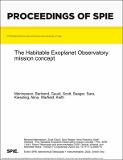The Habitable Exoplanet Observatory mission concept
Author(s)
Mennesson, Bertrand; Gaudi, Scott; Seager, Sara; Kiessling, Alina; Warfield, Keith; HebEx Study Team; ... Show more Show less
DownloadPublished version (7.572Mb)
Publisher Policy
Publisher Policy
Article is made available in accordance with the publisher's policy and may be subject to US copyright law. Please refer to the publisher's site for terms of use.
Terms of use
Metadata
Show full item recordAbstract
The Habitable Exoplanet Observatory (HabEx), was one of four candidate flagship missions studied in detail by NASA, which were submitted for consideration to the 2020 Decadal Survey in Astronomy and Astrophysics for possible launch in the 2030s. For the first time in human history, technologies have matured sufficiently to enable an affordable space-based telescope mission capable of discovering and characterizing Earthlike planets orbiting nearby bright sun-like stars to search for signs of habitability and biosignatures. Such a mission can also be equipped with instrumentation that will enable broad and exciting general astrophysics and planetary science not possible from current or planned facilities. HabEx was designed to be the Great Observatory of the 2030s and beyond, with unique imaging and multi-object spectroscopic capabilities at wavelengths ranging from ultraviolet (UV) to near-IR.
Date issued
2020-12Department
Massachusetts Institute of Technology. Department of Earth, Atmospheric, and Planetary Sciences; Massachusetts Institute of Technology. Department of Aeronautics and AstronauticsJournal
Proceedings of SPIE - The International Society for Optical Engineering
Publisher
SPIE-Intl Soc Optical Eng
ISSN
0277-786X